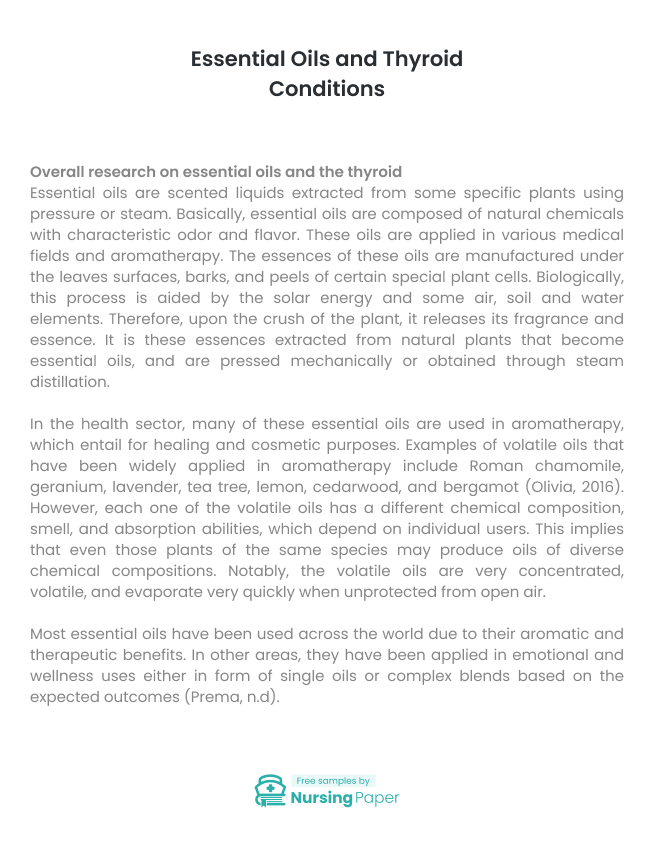1. Prema L. T. (n.d). The Guide to Self-Healing with Essential Oils and Sharing Them with Others. Restoring Health with the Power of Natural Essences. http://www.prema-lia.com/graphics/7-2-14/Completed_doTERRA_Manual_10_28_14.pdf
2. LaRee W. (2012). Butterfly Miracles with Essential Oils. The USA. Butterfly Expressions LLC. http://www.butterflyexpressions.org/Handouts/EssentialOils.pdf
3. Wei M. (2017). 6 Aromatherapy Essential Oils for Stress Relief and Sleep. Web. Retrieved from https://www.huffingtonpost.com/marlynn-wei-md-jd/6-aromatherapy-essential-_b_9805630.html
4. Ali B., et al., (2015). Essential oils used in aromatherapy: A systemic review. Asian Pacific Journal of Tropical Biomedicine 2015; 5(8): 601–611. https://ac.els-cdn.com/S2221169115001033/1-s2.0-S2221169115001033-main.pdf?_tid=9b55eefe-17de-11e8-8d1e-00000aacb362&acdnat=1519310729_1cde193b2f3eb59693bd19b70cd6a02c
5. Aromatherapy.com (2010). The Balance and Harmony of Body and Mind. Most Popular Essential Oils. Web. http://www.aromatherapy.com/most_popular.html
6. Nazzaro, F., Fratianni, F., De Martino, L., Coppola, R., & De Feo, V. (2013). Effect of Essential Oils on Pathogenic Bacteria. Pharmaceuticals, 6(12), 1451–1474. https://www.ncbi.nlm.nih.gov/pmc/articles/PMC3873673/
7. Gautam, N., Mantha, K. A. & Mittal, S. (2014). Essential Oils and Their Constituents as Anticancer Agents: A Mechanistic View. Biomed Res Int. 2014; 2014: 154106. Published online 2014 Jun 9. doi: 10.1155/2014/154106. https://www.ncbi.nlm.nih.gov/pmc/articles/PMC4070586/
8. National Cancer Institute (2017). Aromatherapy and Essntial Oils (PDQ). Patient Version. https://www.ncbi.nlm.nih.gov/pubmedhealth/PMH0032518/
9. Can Baser, K. H. & Buchbauer, G. (2010). Handbook of Essential Oils Science, Technology, and Applications. New York. CRC Press, Taylor & Francis Group. http://naturalingredient.org/wp/wp-content/uploads/handbookofessentionaloil.pdf
10. Dhifi W., Bellili S., Jazi S., Bahloul N.,3 & Mnif W. (2016). Essential Oils’ Chemical Characterization and Investigation of Some Biological Activities: A Critical Review. file:///C:/Users/Nicholas/Downloads/medicines-03-00025.pdf
11. Mallappa K. S., Mohd S. A. & Uma R. S. (2016). Antimicrobial Properties of Plant Essential Oils against Human Pathogens and Their Mode of Action: An Updated Review. https://www.hindawi.com/journals/ecam/2016/3012462/
12. Ewao.com. (2011). Are Essential Oils the New Antibiotics? Web. Retrieved on February 22, 2018, from http://ewao.com/2017/12/10/are-essential-oils-the-new-antibiotics/
13. Natalie J. Wu-Woods (2009). Do Essential Oils from Herbs Inhibit the Growth of Bacteria? http://cssf.usc.edu/History/2009/Projects/J1732.pdf
14. Dr. Axe (2018). Hypothyroidism Diet + Natural Treatment. Web. Retrieved on 23 February 2018 from https://draxe.com/hypothyroidism-diet-natural-treatment/
15. Olivia F. (2016). Use These Essential Oils To Heal Your Thyroid Naturally & Smell Great All Day Long. Web. Retrieved on 23 February 2018 from https://www.mindbodygreen.com/0-26453/use-these-essential-oils-to-heal-your-thyroid-naturally-smell-great-all-day-long.html
16. Trentini D. (2014). How to use Essential Oils for an Underactive Thyroid. Retrieved from https://hypothyroidmom.com/how-to-use-essential-oils-for-an-underactive-thyroid/
17. Vandana B., Kavya N., Shubhashree M. N., & Sulochana B. (2017). Herbal approach to management of thyroid disease – a review. J Ayu Herb Med ǀ Vol 3 Issue 1 ǀ January- March 2017. http://www.ayurvedjournal.com/JAHM_201731_09.pdf
18. The Alternative Daily (July 6, 2015). Best Essential Oils for an Underactive Thyroid. https://www.thealternativedaily.com/best-essential-oils-for-an-underactive-thyroid/
19. Johnathan (n.d). Essential Oils for Thyroid (Under-active, Over-active, Hyperthyroidism). https://www.healthwatchlist.com/essential-oils-thyroid/
20 . Mahdy T. (n.d). Thyroid: The Thyroid Gland the Thyroid Gland. http://osp.mans.edu.eg/tmahdy/handy_resources/Dental/Thyroid_pre.pdf

The download will start shortly.






 Subject:
Subject:
 Number of pages: 14
Number of pages: 14